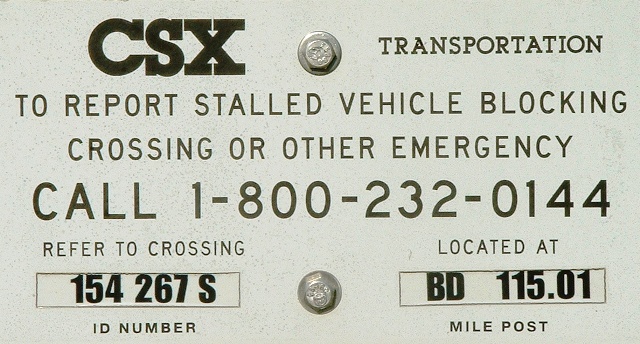
- Trains operate under rigid speed restrictions that are monitored very closely by the railroads and regulatory agencies. Many freight trains average a mile in length. If the train is traveling 50 to 60 MPH, it takes about a minute to clear a crossing. At 30 MPH, it takes about two minutes to clear a crossing.
- Trains have the right-of-way because they cannot quickly stop for a motorist at crossings or for trespassers on the tracks. The average freight train, traveling at 55 MPH, takes anywhere from 1 to 1½ miles to stop. Traveling at the same speed, the average automobile can stop in only 200 feet. The heavier the object, the longer the stopping distance. In addition, the contact surface between a train's steel wheels and the steel rails is only the size of a dime! That results in very little friction created when compared to automobile tires on asphalt or concrete.
- There are several numbers to call in order to get a train stopped or to report a malfunctioning crossing signal. Some crossings feature signs with a 1-800 number to use to call the railroad directly and warn them of stalled vehicles or other crossing problems. You can also call 911and provide local police with the crossing location, which is generally the name of the road intersecting the tracks or the nearest town, and they will contact the railroad. The railroad dispatcher can reach the locomotive engineers by radio and they will do everything possible to stop approaching trains. Stay off the tracks and don't try to flag down the train. The train engineer will not be able to stop the train by the time they see you.
- Every motor vehicle operator is required by law to bring their car, truck or motorcycle to a full stop at a highway-rail grade crossing when warned of an approaching locomotive or train by flashing lights. They cannot cross until the approaching locomotive or train has passed or until directed to do so by emergency personnel. If gates at the crossing are in the lowered position, drivers must not go around them. It is against the law to drive around lowered gates. When a crossing signal system is activated, a train is almost always in the approach circuits, but may be blocked from view.
- Funding for automatic warning devices often comes from limited public sources. A typical installation can cost $400,000 or more. Once installed, the railroad maintains the crossing signal system. Many factors, such as frequency and speed of rail traffic, motor vehicle traffic, and crossing collision history are considered when determining which crossings will be signalized.
- Rail crossing gates serve to warn drivers, not as impenetrable barriers. Vehicles sometime get trapped on the crossing when the gate lowers behind them. The gate is made of a lightweight material that will yield when struck by a vehicle, thus providing an escape for a trapped motorist.
- Federal law requires trains to sound their horn at all highway-rail grade crossings. Drivers often do not pay attention or do not expect to see a train at familiar crossings. The blast of a locomotive horn may be the only warning that gets the driver's attention. Never assume that a seldom-used track has been abandoned.
- To notify officials about poor visibility at a railroad crossing, please contact INDOT Customer Service at 855-463-6848, or the railroad directly using the 1-800 number posted at the crossing.
- Railroad property is private property and access is limited to railroad personnel and those persons who have been granted access by the railroad. Violators can be charged with trespassing. Nationally every year, more than 500 people who trespass on railroad right-of-way are killed and many others are critically injured.
Contact Information
Transportation Services Call Center
Indiana Department of Transportation
100 N. Senate Ave., IGCN 755
Indianapolis, IN 46204
855-463-6848
indot4u.com
